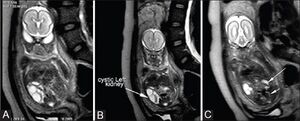Amniotic fluid
Amniotic fluid and amniotic membranes such as the chorion and amnion form a sac of membranes in which the fetus develops. The source of amniotic fluid is the surface of the amnion, skin and alveoli of the fetus. After the 16th week of pregnancy the biggest proportion of amniotic fluid is fetal urine. Resorption of this occurs from the 5th month by the fetal digestive system.
Amniotic fluid is essential for fetal growth and development. It protects the fetus from injury, promotes lung growth, and provides protection against infections. Its volume increases with gestational age and reaches its maximum around the 36th - 37th week of pregnancy at a volume of 800 - 1000 ml. An increased volume of amniotic fluid (polyhydramnios) is associated with fetal anomalies (about 20% of fetuses with polyhydramnios have congenital defects), a reduced volume of amniotic fluid (oligohydramnios) negatively affects lung development. The most common cause of oligohydramnios is rupture of the amniotic sac. Moreover, in the second half of pregnancy, the amniotic fluid is made up mainly of the fetus's urine, therefore reduced urine production or a disorder of urine excretion can cause of oligohydramnios, and on the other hand, a swallowing disorder or obstruction of the digestive tract can lead to polyhydramnios.[1]
Quantity:[edit | edit source]
- changes during pregnancy;
- the maximum – 1 liter – in the 35th week of pregnancy;
- it decreases afterwards - at the end of pregnancy - 0.7-1 liter;
- during delayed delivery - the end of the 42nd week - it can decrease to 300 ml.
Measurements:
- amniotic fluid index ( amniotic fluid index , AFI): during an ultrasound examination, the abdomen of a pregnant woman is divided into 4 quadrants, and the largest pocket of amniotic fluid is measured, the sum of the four obtained measurements is the AFI.
- Polyhydramnios is defined as AFI > 24 cm in total or > 8 cm in one pocket; total volume of amniotic fluid > 2 liters.
- Oligohydramnios is defined as AFI < 7 cm in total or < 2-3 cm in one pocket.[1]
Composition:[edit | edit source]
- 99 % water;
- electrolytes, glucose, proteins, fats, creatinine, urinary substances (from the 3rd month);
- as the pregnancy continues, the amount of electrolytes decreases and the concentration of phospholipids increases (used to determine the maturity of the fetus)
- in the late stages of pregnancy, amniotic fluid is exchanged every 3 hours.
Function:[edit | edit source]
- protection against mechanical damage to the fetus;
- fetal nutrition and metabolism.
An adequate amount of amniotic fluid is necessary for normal fetal development. Deviations in its amount can signal the malfunction of some organs. Video - plod polyká plodovou vodu -
Oligohydramnios[edit | edit source]
Reduced amount of amniotic fluid.
Causes:
- congenital defects of the urinary tract: agenesis of the kidneys, polycystic kidneys, obstruction of the urinary tract (valve of the posterior urethra);
- premature outflow of amniotic fluid, chronic leakage of amniotic fluid;
- placental insufficiency – pregnancy-induced hypertension, maternal diabetes, fetal dysmaturity (after the 42nd week of pregnancy);
- maternal use of inhibitors of prostaglandin synthetase (cyclooxygenase) or angiotensin-converting enzyme .[1]
Polyhydramnios[edit | edit source]
Excessive amniotic fluid.
Causes:
- twin-to-twin transfusion syndrome;
- congenital defects of the fetus: esophageal atresia , tracheal agenesis, duodenal atresia and other intestinal atresia;
- CNS malformation and neuromuscular diseases associated with swallowing complications;
- srdeční arytmie asociované s hydropsem plodu;
- feto-maternal bleeding;
- parvovirus infection;
- untreated maternal diabetes mellitus;
- chromosomal abnormalities : trisomy 21, 18, 13;
- fetal akinesia syndrome with absence of swallowing.[1]
Links[edit | edit source]
Related articles[edit | edit source]
References[edit | edit source]
- ↑ a b c d CARTER, BS. Polyhydramnios and Oligohydramnios [online]. Medscape, ©2017. [cit. 2020-11-01]. <https://reference.medscape.com/article/975821-overview>.
- ZOBAN, P – ČERNÝ, M – DROBNÁ, H. Neonatologický edukační program, modul I. 1. edition. Třinec : T-PRINT s. r. o., 1996. 5 pp. vol. 1.
- KOBILKOVÁ, Jitka. Základy gynekologie a porodnictví. 1. edition. Praha : Galén, 2005. 368 pp. ISBN 80-7262-315-X.


